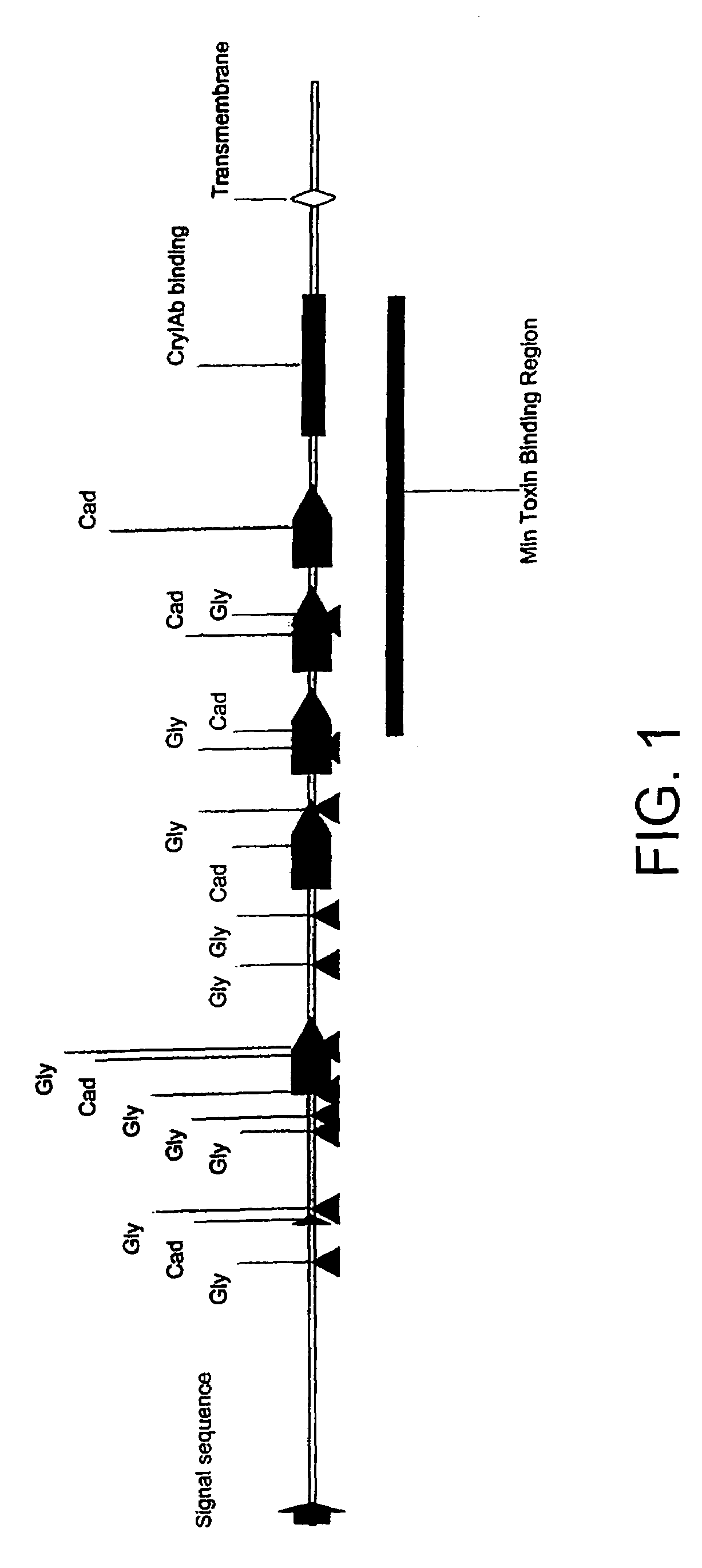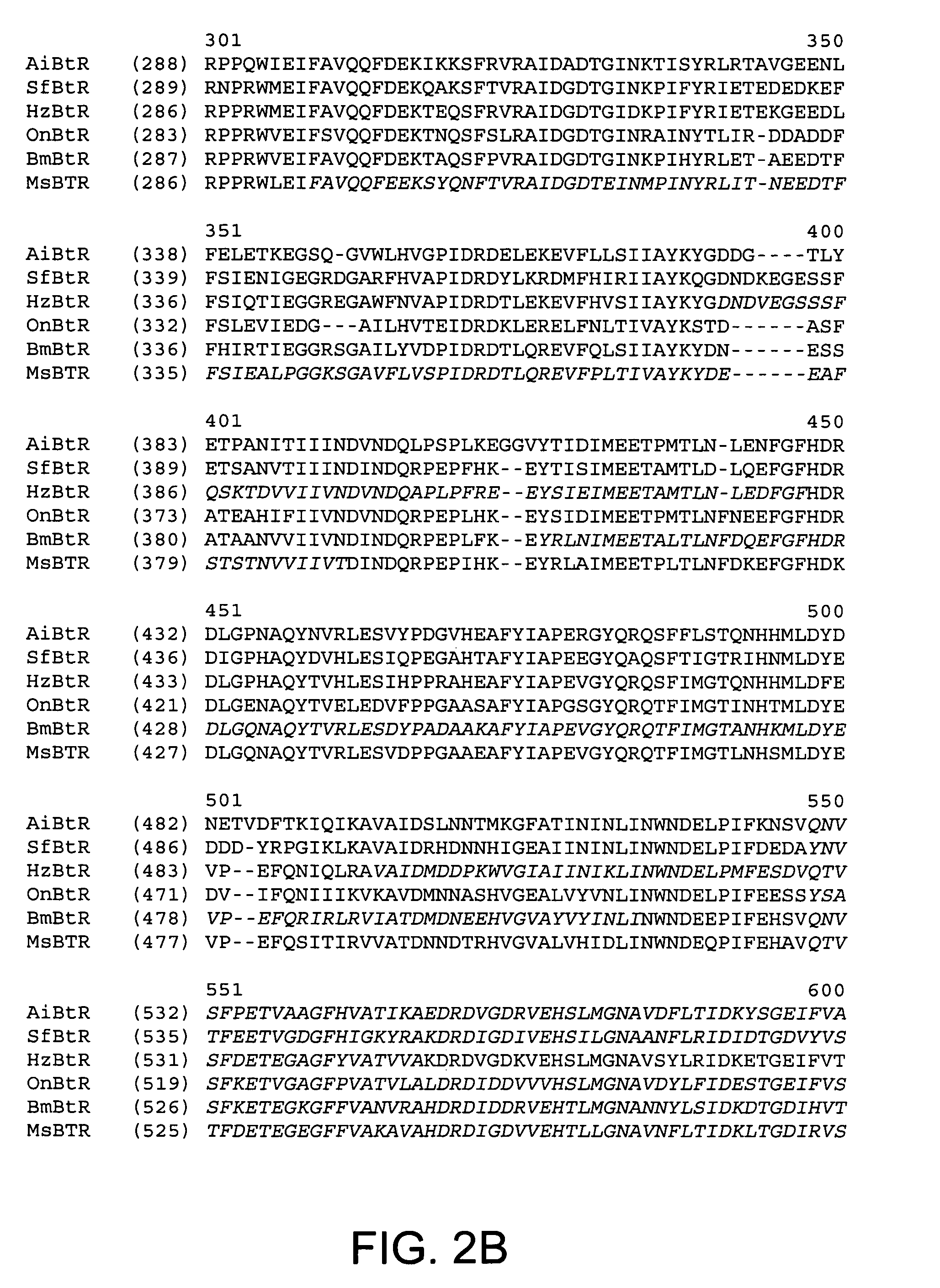Bt toxin receptors and methods of use
a technology of bt toxin and receptor, applied in the field of manipulation of bt toxin susceptibility, can solve the problems of developing resistance to bt toxin and a challenge in pest control, and achieve the effect of managing bt toxin resistan
- Summary
- Abstract
- Description
- Claims
- Application Information
AI Technical Summary
Benefits of technology
Problems solved by technology
Method used
Image
Examples
example 1
Isolation of EC Bt Toxin Receptor
[0112]Standard recombinant methods well known to those of ordinary skill in the art were carried out. The Align X program (a component of Vector NTI® Suite software available from Informax, Inc., Bethesda, Md.) was used to identify regions of homology between the protein sequences for the Bt receptors from corn pests including fall armyworm (Spodoptera frugiperda), corn earworm (Helicoverpa zea), and European corn borer (Ostriania nubilalis). The nucleotide sequences encoding the identified regions of homology were then compared and evaluated to identify sequences having a low level of fold degeneracy. Fold degeneracy represents the total number of oligonucleotide sequences required to represent all the possible ways to code for a given sequence of amino acids (see Sambrook et al. (1989) Molecular Cloning, a Laboratory Manual 2nd Ed.). PCR primers were then designed based on regions of the aligned sequences that could be used to generate oligonucleot...
example 2
Binding and Cell Death in Lepidopteran Insect Cells Expressing the Bt Toxin Receptors of the Invention
[0123]An in vitro system is developed to demonstrate the functionality of a Bt toxin receptor of the invention. Well known molecular biological methods are used in cloning and expressing the BCW Bt toxin receptor in Sf9 cells. A baculovirus expression system GIBCO™ Invitrogen Corporation, Carlsbad, Calif.) is used according to the manufacturer's provided protocols and as described below. S. frugiperda (Sf9) cells obtained from ATCC (ATCC-CRL 1711) are grown at 27° C. in Sf-900 II serum free medium (Gibco™ Invitrogen Corporation, Carlsbad, Calif.). These cells, which are not susceptible to Cry1Ab toxin, are transfected with an expression construct (pFastBac1 bacmid, Gibco™ Invitrogen Corporation, Carlsbad, Calif.) comprising an operably linked Bt toxin receptor of the invention (SEQ ID NO:1) downstream of a polyhedrin promoter. Transfected Sf9 cells express the BCW Bt toxin receptor ...
example 3
Tissue and Subcellular Expression of the BCW Bt Toxin Receptor
[0131]Fifth instar BCW are dissected to isolate the following tissues: fat body (FB), malpighian tubules (MT), hind gut (HG), anterior midgut (AM) and posterior midgut (PM). Midguts from fifth instar larvae are also isolated for brush border membrane vesicle (BBMV) preparation using the well known protocol by Wolfersberger et al. (1987) Comp. Biochem. Physiol. 86A:301–308. Tissues are homogenized in Tris buffered saline, 0.1% tween-20, centrifuged to pellet insoluble material, and transferred to a fresh tube. 50 μg of protein from each preparation is added to SDS sample buffer and B-mercaptoethanol, heated to 100° C. for 10 minutes and loaded onto a 4–12% Bis-Tris gel (Novex). After electrophoresis, the proteins are transferred to a nitrocellulose membrane using a semi-dry apparatus. The membrane is blocked in 5% nonfat dry milk buffer for 1 hour at room temperature with gentle agitation. The primary antibody is added to ...
PUM
| Property | Measurement | Unit |
|---|---|---|
| Fraction | aaaaa | aaaaa |
| Fraction | aaaaa | aaaaa |
| Current | aaaaa | aaaaa |
Abstract
Description
Claims
Application Information
 Login to View More
Login to View More - R&D
- Intellectual Property
- Life Sciences
- Materials
- Tech Scout
- Unparalleled Data Quality
- Higher Quality Content
- 60% Fewer Hallucinations
Browse by: Latest US Patents, China's latest patents, Technical Efficacy Thesaurus, Application Domain, Technology Topic, Popular Technical Reports.
© 2025 PatSnap. All rights reserved.Legal|Privacy policy|Modern Slavery Act Transparency Statement|Sitemap|About US| Contact US: help@patsnap.com



